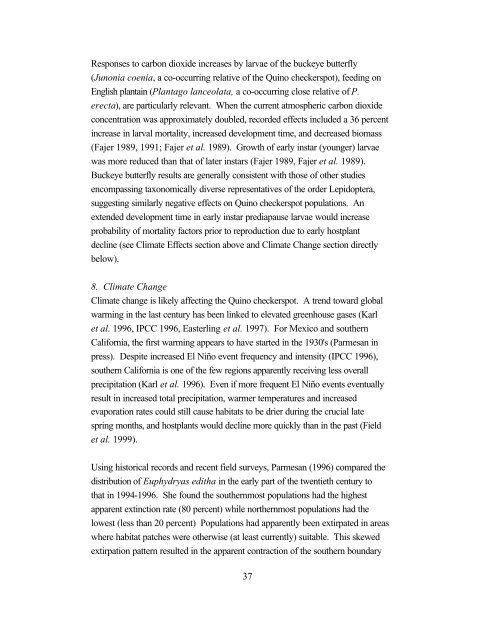Outline of Quino Recovery Plan - The Xerces Society
Outline of Quino Recovery Plan - The Xerces Society
Outline of Quino Recovery Plan - The Xerces Society
Create successful ePaper yourself
Turn your PDF publications into a flip-book with our unique Google optimized e-Paper software.
Responses to carbon dioxide increases by larvae <strong>of</strong> the buckeye butterfly<br />
(Junonia coenia, a co-occurring relative <strong>of</strong> the <strong>Quino</strong> checkerspot), feeding on<br />
English plantain (<strong>Plan</strong>tago lanceolata, a co-occurring close relative <strong>of</strong> P.<br />
erecta), are particularly relevant. When the current atmospheric carbon dioxide<br />
concentration was approximately doubled, recorded effects included a 36 percent<br />
increase in larval mortality, increased development time, and decreased biomass<br />
(Fajer 1989, 1991; Fajer et al. 1989). Growth <strong>of</strong> early instar (younger) larvae<br />
was more reduced than that <strong>of</strong> later instars (Fajer 1989, Fajer et al. 1989).<br />
Buckeye butterfly results are generally consistent with those <strong>of</strong> other studies<br />
encompassing taxonomically diverse representatives <strong>of</strong> the order Lepidoptera,<br />
suggesting similarly negative effects on <strong>Quino</strong> checkerspot populations. An<br />
extended development time in early instar prediapause larvae would increase<br />
probability <strong>of</strong> mortality factors prior to reproduction due to early hostplant<br />
decline (see Climate Effects section above and Climate Change section directly<br />
below).<br />
8. Climate Change<br />
Climate change is likely affecting the <strong>Quino</strong> checkerspot. A trend toward global<br />
warming in the last century has been linked to elevated greenhouse gases (Karl<br />
et al. 1996, IPCC 1996, Easterling et al. 1997). For Mexico and southern<br />
California, the first warming appears to have started in the 1930's (Parmesan in<br />
press). Despite increased El Niño event frequency and intensity (IPCC 1996),<br />
southern California is one <strong>of</strong> the few regions apparently receiving less overall<br />
precipitation (Karl et al. 1996). Even if more frequent El Niño events eventually<br />
result in increased total precipitation, warmer temperatures and increased<br />
evaporation rates could still cause habitats to be drier during the crucial late<br />
spring months, and hostplants would decline more quickly than in the past (Field<br />
et al. 1999).<br />
Using historical records and recent field surveys, Parmesan (1996) compared the<br />
distribution <strong>of</strong> Euphydryas editha in the early part <strong>of</strong> the twentieth century to<br />
that in 1994-1996. She found the southernmost populations had the highest<br />
apparent extinction rate (80 percent) while northernmost populations had the<br />
lowest (less than 20 percent) Populations had apparently been extirpated in areas<br />
where habitat patches were otherwise (at least currently) suitable. This skewed<br />
extirpation pattern resulted in the apparent contraction <strong>of</strong> the southern boundary<br />
37
















